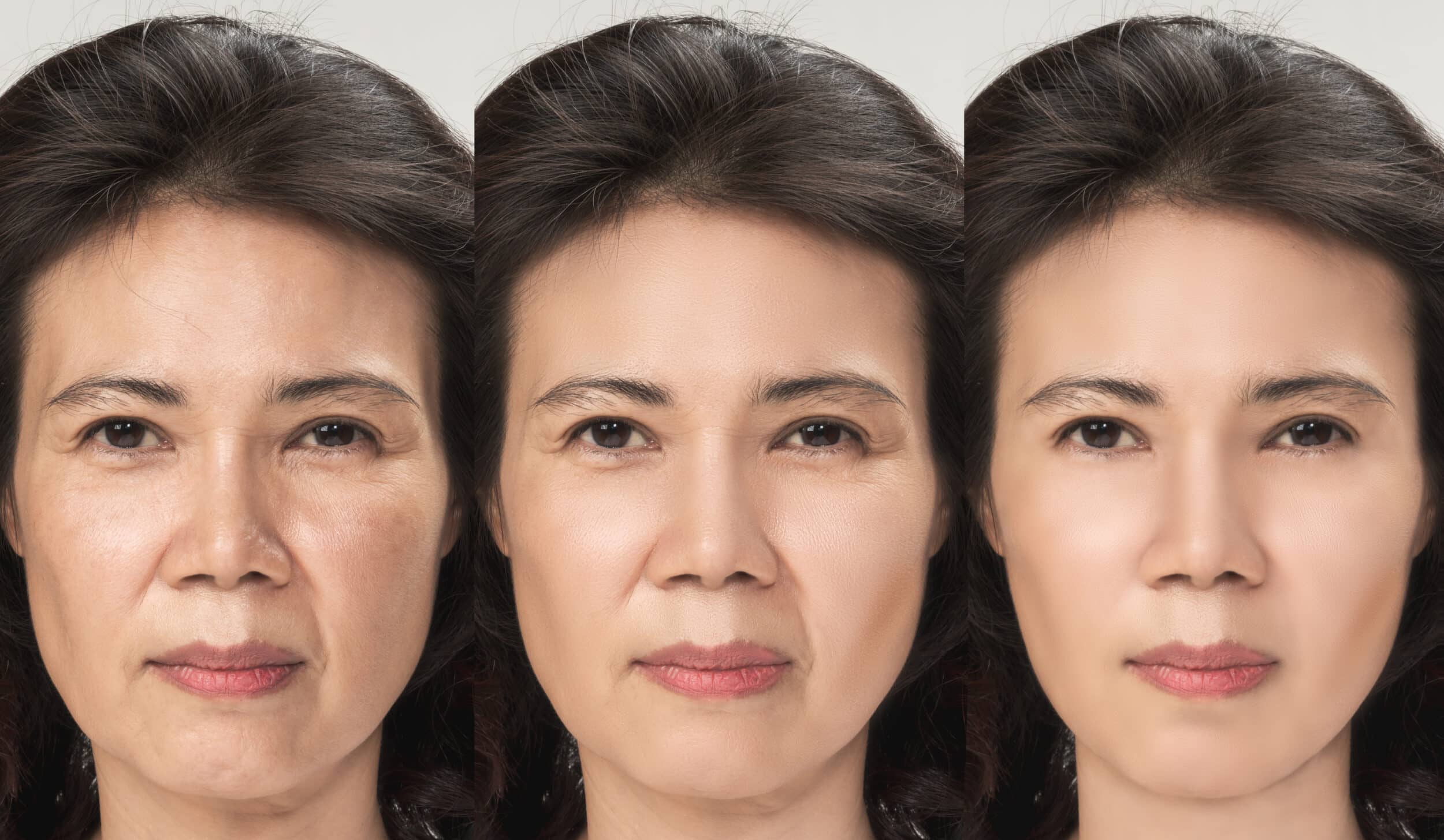
If you are concerned with facial wrinkles, loose skin, or other signs of aging, you may want to consider the benefits of a facelift. Also known as a rhytidectomy, a facelift is one of the most popular procedures in cosmetic surgery. It can improve the contours of your face and restore a healthy, youthful appearance. Because of individual factors, not everyone will achieve the same results from a facelift.
The face has some of the thinnest skin on the entire human body. It is also exposed to the sun and environmental damage all the time. Couple this with the decline in collagen production (collagen provides the skin’s structural support) that comes with aging and the result is sagging skin and lost volume. A facelift with Dr. Lipton can address these issues and take 10-15 years off your face.
What Is A Facelift?
If you are concerned with facial wrinkles, loose skin, or other signs of aging, you may want to consider the benefits of a facelift. Also known as a rhytidectomy, a facelift is one of the most popular procedures in cosmetic surgery. It can improve the contours of your face and restore a healthy, youthful appearance. Because of individual factors, not everyone will achieve the same results from a facelift.
Ideal Candidate For Facelift Surgery
Most anyone over the age of 45 could benefit from a facelift. Much depends on how much sun exposure you’ve had, and what other factors such as smoking and stress have impacted your facial skin. These are characteristics Dr. Lipton looks for when a patient is considering a facelift:
- Mid-face sagging
- Jowls
- Deep nasolabial folds
- Deep creases under the eyes
- Fatty, loose areas below the cheekbones
- Banding, fatty tissue, and loose skin on the neck


What Are The Different Facelift Facelift Lewisville TX. | Stuart Lipton, MDOptions?
New technology and methods allow Dr. Lipton to perform different types of facelifts depending on individual patient needs.

Full Facelift
This is also known as a traditonal facelift and involves the largest degree of lifting and repositioning of the muscles and other involved tissues. Incisions begin at the temples on each side of the face, run down in front of the ears, wrap around the earlobes, and terminate in the hairline behind the ears. Excess skin is trimmed before being re-draped, and Dr. Lipton repositions most of the fat to avoid the patient acquiring a hollow look. If you have excessive sagging skin on your neck, a second incision may be made under the chin to allow Dr. Lipton to lift, tighten, and trim the skin and muscle of your neck.
Mid-Face Lift
The target here is the mid-face, particularly the cheeks and the areas under the eyes. Mid-face lifts can correct deep nasolabial folds (creases running from the nose down to the corners of the mouth), reduce puffiness under the eyes, and improve the contour of the cheeks. For a mid-face lift, Dr. Lipton makes small incisions in the lower eyelids or the mouth. Limited-incision facelift— If you don’t have too much-sagging skin, this method can be a good option. This facelift provides limited rejuvenation around the eyes and mouth. Shorter incisions are made at the temples, around the ears, and possibly in the lower eyelids and/or under the upper lip.
Neck Lift
While not technically a facelift, neck lifts are often combined with a facelift to address sagging and banding on the patient’s neck. Incisions are made around the earlobe and behind the ear into the lower scalp. An additional incision may be made under the chin. The focus is the jowls and fat under the chin.
Does Facelift Treat Brows And Eyelids?
There is a misperception that a facelift covers the entire face. Actually, a facelift deals with the lower two-thirds of the face. The muscle and tissue anatomy on the brows and around the eyes is far different than the lower face. To address these other areas, patients often combine a brow lift and eyelid surgery with their facelift.
Facelift Recovery
With facelifts, a good deal of tissue is lifted and repositioned, leading to tissue trauma, swelling, and bruising. After your surgery, your face will be wrapped in bandages and you will likely have drainage tubes in place. The first few days are not easy, but you’ll quickly improve from there. For the first week, you’ll need to sleep with your head elevated. Your skin will feel tight, as you would expect. With most facelifts, due to the tissue repositioning, there are usually some areas of numbness. This is normal and is the result of facial nerves needing to adjust to your re-draped skin. Most patients can return to work around the third week after their facelift surgery, possibly sooner for limited-incision facelifts.
When Will I See My Results?
There is swelling with any facelift. This will keep you from seeing your final results until the swelling decreases. It may be a few months before your swelling fully resolves. Also, swelling can come and go, especially later in the day.

How Long Will My Results Last?
The results of your facelift are permanent. Your face will look 10-15 years younger, and this will not change. You will, of course, continue to age, but you will age from a younger starting point. To keep up with this aging, many patients have a more limited procedure again in five to 10 years.
"Dr. Lipton is the best surgeon ever! He is very knowledgeable, professional and really cares about his patients. His staff??? Amazing!!! The service they provide is over the top and they always go above and beyond with a smile. 😊 When I first started looking for a surgeon I asked several people for referrals. Dr. Lipton was highly recommended with so many success story’s! I am so happy I chose Dr. Lipton and thrilled with my results. If you are looking for a plastic surgeon you can trust with many years of experience... look no further. I emplore you to call Dr. Lipton’s office."
What Will My Scarring Be Like?
Most of your incisions are made within the hairline to keep visible scarring to a minimum. The techniques used and experience of Dr. Lipton will leave scars that heal well and become quite inconspicuous.
What Are The Risks With A Facelift?
A facelift is a major surgery, and it includes the risks associated with surgery: bleeding, infection, hematoma, and the like. Beyond those general risks of surgery, facelifts can create a temporary loss of muscle function and sensation. The incision scars can thicken and widen, especially if recovery procedures are not followed. There can be hair loss at the incision sites within the hairline. These complications are rare, however, and facelifts are a very satisfying procedure for the vast majority of patients.
What Should I Expect During Facelift Recovery?
After having a facelift, you can expect a recovery period of a few weeks before you’re “social ready.” Being social ready means that you can feel comfortable returning to work and other activities without self-consciousness about bruising or swelling. After about two weeks, bruising and swelling that linger are generally mild enough to be disguised with makeup. Initially, these side effects will keep you from wanting to be out and about in your normal life. Your incisions, though mostly behind the ears and hairline, will probably be raised and red. Your stapes or stitches may make incisions more noticeable for a few days. After about a week, however, the stitches may be removed and your incision lines will gradually lighten and flatten out from there. You may also wear an elastic compression wrap around your chin and head for at least a day or two.
During the first few days of your recovery period, swelling and bruising may worsen. Depending on the part of your face that has been treated, these side effects may extend down the neck and to the chest. This is normal and should resolve over 10 to 14 days. You may rely on prescription pain medication for up to a week to 10 days, after which over-the-counter pain relievers may suffice. As the nerve endings in the facial area come back to life, you may transition from numbness to other sensations, including temporary shooting pains.
What Can I Do To Recover Well From My Facelift?
Rest may be your top priority after your facelift procedure. When you sleep, your body engages in a number of repair processes that will help your incisions heal and the natural tissue-tightness to soften over time. To facilitate optimal healing, you might sleep with your head elevated for about a week. You can do this by sleeping in a recliner or placing two to three pillows behind your head.
Allow one to two weeks for your facelift recovery, but plan to walk daily beginning as soon as the day of your procedure. You might begin by walking for about five minutes, gradually increasing your time and distance as you feel ready. It is imperative that you abstain from strenuous exercise, heavy lifting, and other activities that could strain your incisions or significantly increase your heart rate. Men who undergo facelift surgery must be extra careful when they shafe during their recovery period. This is because tissue numbness could increase the risk of accidental cuts.
Because your facial tissue will be sore after your facelift, you may prepare for a more comfortable recovery by stocking up on soft foods. This can help decrease the amount of chewing and pressure that occurs while tissues heal. During your first week of recovery, you may benefit the most from eating foods like eggs, oatmeal, soup, smoothies, yogurt, and pasta.
Will My Face Look Natural After A Facelift?
Right after your facelift, your skin will most likely took tight. Keep in mind that your surgeon will perform your procedure very carefully to avoid pulling the skin too tight. The initial tightness that appears is mostly due to swelling. Once the swelling goes down, you can expect to see more youtful facial contours, not an upswept windblown look. To get a good idea of your potential results, we invite you to carefully observe our before and after photos.
Is A Full Facelift Right For Me?
Dr. Lipton performs a few different types of facelifts. Usually, when a patient expresses questions about a full facelift, it indicates concern about the appearance of the eyes and forhead area. Facelift procedures, even a “full facelift,” focuses only on the lower regions of the face. The most extensive facelift may address jowls, flattening in the mid-face, nasolabial folds, and possibly even a turkey neck. If you have concerns related to descending eyebrows or hooded eyelids, you may be a good candidate for a brow lift or eyelid lift. During your consultation, Dr. Lipton will listen to your goals and perform a thorough examination of your facial tissue to determine which treatments or techniques would best serve you.
Schedule A Consultation
For more information on Facelift and to learn if you would be a good candidate for this procedure, contact our office today at (972) 420-0023 to schedule a consultation. Our practice serves Lewisville and surrounding areas in Texas.

